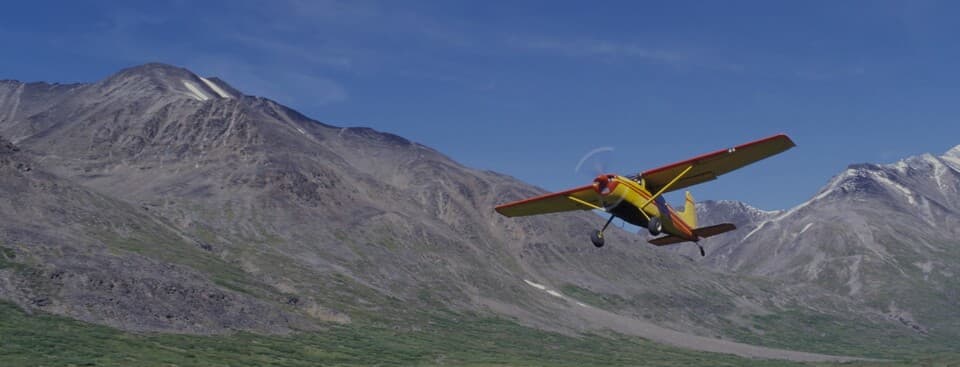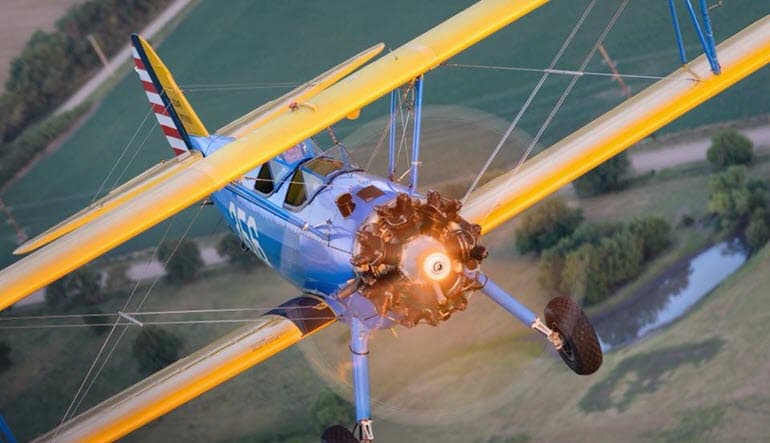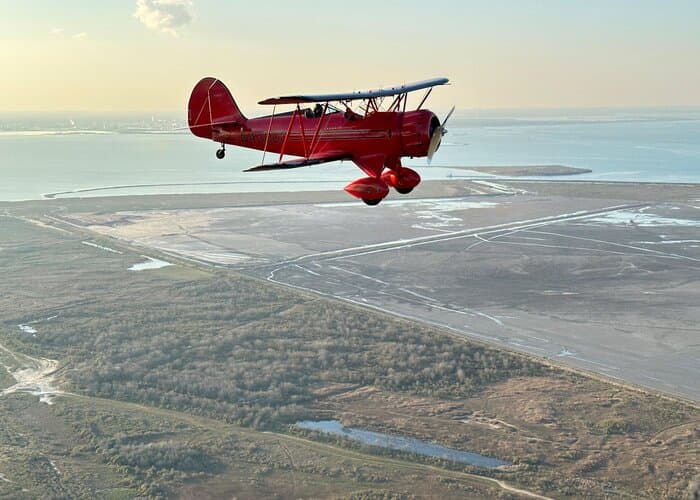
Airplane Flight & Introductory Flight
Take your seat in the cockpit of an airplane for your first flight—an introductory airplane flight (discovery flight) in a light aircraft!
Experience the unique sensations of flying, admire the landscapes from above, and let your certified pilot guide you.
An introductory airplane flight is a one-of-a-kind experience, with brand-new sensations and a fresh perspective.
Fully experience taxi, takeoff, and landing alongside passionate, skilled pilots.
Résultats
- Aerobatic Flight in a Biplane Near Washington

Aerobatic Flight in a Biplane Near Washington From 575 €View22728, Midland - Introductory private airplane flight in Miami

Introductory private airplane flight in Miami From 258 €View33186, Miami - Scenic Biplane Ride Over Galveston

Scenic Biplane Ride Over Galveston From 350 €View77554, Galveston - Airplane Scenic Flight Over San Francisco Bay

Airplane Scenic Flight Over San Francisco Bay From 618 €View94541, Hayward
Landscapes reveal themselves to you from a previously unknown angle: wildlife in its natural habitat, farm fields, majestic mountains, rugged coastlines, shimmering streams, etc.
You will discover certain sites that are not visible by road. Every airplane flight offers its share of surprises. The seasons, the weather, and the time of the flight bring changing colors and reflections on the ground with every flight.
Is taking the aircraft’s controls a childhood dream?
Why not choose the “Flight Lesson” option to acquire the basics of piloting (techniques and handling of instruments) so you can take the airplane’s controls safely?
Make your dream come true and become a light-airplane pilot!
Whether you are a beginner or already have a few flight hours, flight lessons help you refine your skills and live your passion for aviation more closely.
Training or introductory flight—come discover the pleasures of airplane flying in complete safety and enjoy an extraordinary panorama.
And how about giving an airplane flight for a birthday? Our partners offer gift certificates for every occasion!
Discover the airplane flight experience
Airplane flight is a dream for many of us. No need to be an aviation expert—the simple fact of flying over beautiful places remains an attractive aerial activity and a source of wonder. It is also possible to travel by private airplane with a private jet charter that lets you go from point to point while enjoying the premium service of business aviation. Many airports in the United States are available and have dedicated FBOs/general-aviation terminals.
Introductory airplane flight
What is an introductory flight?
An introductory airplane flight is for anyone who wants to make a very first flight. It is a unique opportunity to discover the world of aviation with its very specific sensations and spectacular views.
For this introductory flight, an experienced pilot accompanies you and ensures your safety throughout the flight. You board a light airplane for a short duration, generally between 15 and 30 minutes. This first flight requires no prior knowledge and is open to everyone, adults and children alike.
The sensations of the first flight
The first airplane flight is often described as a fabulous, magical, and memorable experience. From takeoff, the adrenaline rises as the airplane leaves the ground and climbs. The panorama is majestic and the environment below brings discoveries and surprises. The sound of the engines, the wind, and the sensation of lightness create a mix of excitement, fulfillment, and serenity.
Many describe their introductory flight as a moment of pure freedom and wonder, etched in their memory forever.
Why choose an introductory airplane flight?
Choosing an introductory airplane flight is an excellent option to discover aviation in a safe, supervised way.
This aerial activity is for you if you enjoy thrills and new experiences. For those who are anxious about flying, it is a good solution to discover the world of aviation and overcome your fears.
The introductory flight sometimes gives some people the desire to go further by starting airplane pilot training or renewing the experience with an aerobatic airplane flight.
For the joy of flying or as a gift for a friend, an introductory airplane flight is an unforgettable adventure!
Flight simulators
If the weather is not favorable, or if you are hesitant to board a “real” airplane, an airplane flight simulator experience is a very good solution. The simulator is an excellent tool, either to allow you to discover aviation safely or to perfect your flying techniques.
There are several types of simulators, from light-aircraft simulators to very advanced airliner simulators. All have the same objective: reproducing as accurately as possible the real operation of a true airplane.
Simulators therefore have a cockpit reproducing the aircraft’s instruments and screens showing the landscapes you would see on a real flight.
Scenic flights in light airplanes
A light-airplane flight offers a unique and captivating way to explore varied landscapes. Unlike ground transportation, the airplane lets you fly over remote areas and admire spectacular panoramic views, for example, you can choose a light-airplane flight in Northern California and discover the landscapes of this region between Napa and Sacramento.
An introductory flight gives an overall view of the topography and geography of the area flown over.
Introductory airplane flights and Airplane tours let you discover beautiful landscapes from above without learning to fly. These flights are made for sightseeing and enjoying the views, whether it’s along the Pacific Coast, over the Grand Canyon, or around Lake Tahoe. Each airplane tour gives you a great overview and a memorable experience during your trip.
The best scenic routes
Among the most popular destinations:
The Rockies (Colorado/Utah): snowy peaks, alpine valleys, national parks.
The Pacific Coast (California): coastline, coastal towns, beaches, and clear waters.
The Atlantic Coast (North Carolina/Outer Banks): deep blue waters and dunes.
Hudson Valley (State of New York): historic sites and bucolic scenery.
New England: rugged coasts, lighthouses, and small islands.
Cascade Range (Oregon/Washington): volcanoes, green meadows, lakes.
Airplane flight around Seattle/Puget Sound: American coasts facing the Pacific Ocean.
These routes are designed to offer the best of local landscapes, guaranteeing an exceptional visual and emotional experience.
Tips for a successful light-airplane flight
Here are some practical tips to make your light-airplane flight a success:
Book in advance, especially in high season.
Choose comfortable, weather-appropriate clothing. It can be cooler at altitude, so remember to bring a jacket.
To get the most from the view, choose a day with favorable weather. Clear skies allow better visibility and more pleasant flight conditions.
Listen to and follow the safety instructions given during the briefing.
Take photos: landscapes seen from the air are often spectacular.
Aerobatic airplane flight
If you want to push the adrenaline a little further, opt for an aerobatic airplane flight!
The sky becomes a true playground with loops, spins, rolls, etc.
Introductory aerobatic flights or training courses attract more and more enthusiasts who love strong sensations and thrills.
Learning to fly an airplane
Learning to fly an airplane begins with a good understanding of the fundamental principles of aviation. Flying an airplane involves mastering several essential skills, including navigation, communication with control towers, and management of cockpit instruments. The basic elements include:
Understanding aerodynamics: knowing how the airplane takes off, flies, and lands based on the forces acting on it.
Controlling the airplane: using flight controls such as the yoke, rudder pedals, and throttle.
Safety procedures: learning safety protocols to handle emergency situations.
Reading instruments: knowing how to interpret the information provided by cockpit instruments for precise navigation.
Navigation: using aeronautical charts and navigation tools to plan and follow a flight route.
To learn to fly, several training options are available, adapted to each person’s needs and ambitions. You will also admire beautiful places, for example by booking a light-airplane flight in the Midwest, which will allow you to fly an airplane or simply be a passenger discovering the landscapes between Chicago and Wisconsin.
First step for beginners: the basic certificate, which is practical and theoretical training on piloting fundamentals.
If you want to go further in learning to fly a light airplane, you can consider obtaining the PPL (Private Pilot License).
Safety and regulations
Safety standards in recreational aviation
Safety standards are strictly defined to ensure the protection of pilots, passengers, and people on the ground.
Aircraft maintenance: airplanes are regularly maintained and inspected by certified mechanics. Each aircraft must undergo periodic technical checks to ensure it is in proper working order.
Safety equipment: light airplanes are equipped with safety devices such as seatbelts, fire extinguishers, and communication equipment.
Pilot training: pilots must complete rigorous training and pass exams to obtain their licenses. They must also regularly refresh their skills through proficiency flights and continuing training.
Flight planning: before each flight, careful planning is necessary to evaluate weather conditions, plan the route, etc.
These standards aim to minimize risks and guarantee safe flights for everyone.
Rules to follow for recreational pilots
Recreational pilots must follow a set of rules and regulations to fly safely. Here are some of the main rules:
Pilot license: each pilot must hold a valid license appropriate to the type of airplane flown.
Flight hours: pilots must log their flight hours and respect imposed limits to avoid fatigue.
Weather conditions: pilots must check weather conditions before the flight and avoid flying in unfavorable conditions.
Airspace compliance: following airspace rules, including minimum and maximum altitudes, and avoiding restricted or prohibited areas is essential.
Communication with air-traffic controllers: pilots must maintain regular communication with controllers to receive instructions and updates.
Importance of pre-flight briefings
Briefings ensure everything is in order before takeoff. They are mandatory before each flight, both for the pilot taking the controls and for the passenger doing an introductory flight. The points covered during the briefing are:
Flight planning: study of the route, planned altitudes, waypoints, and any turbulence areas.
Weather analysis: identification of potential disturbances.
Aircraft check: visual inspection of the airplane to ensure it is in good working order and that all safety equipment is present and operational.
Reminder of emergency procedures: review of procedures to follow in case of emergency.
Passenger briefing: presentation of safety instructions, boarding and deplaning procedures, and the use of safety equipment.
These briefings ensure that the pilot and passengers are well prepared and aware of the responsibilities and procedures to follow for a safe flight.
How your first airplane flight unfolds
During your introductory airplane flight, you will be warmly welcomed at the airfield by the pilots, who will explain precisely how the flight will proceed and the rules to follow. Do not neglect this important step. The instructors make it pleasant.
You will receive safety instructions as well as the flight plan. Do not hesitate to ask them questions, especially if you feel stressed. They are used to it and will find the words to help you relax.
With the briefing complete, it is time to board the airplane. The pilot will indicate the passenger seat. Fasten your seatbelt.
Before takeoff, the pilot performs several pre-flight checks, thus ensuring that the airplane’s systems are fully operational.
Head to the runway. The control tower authorizes the pilot to depart. The airplane accelerates on the runway. You feel yourself pushed back into your seat. Then the airplane rises into the sky—a transition full of unique, exhilarating sensations.
During the flight, the pilot comments on the places you fly over. When it is time to return to the airfield, the airplane begins its descent gradually to the landing phase, then taxis slowly to the parking area.
Once the airplane is stopped and the engines shut down, you can unfasten your seatbelt and step out of the airplane.
A debrief allows you to share your impressions with the pilot. A flight certificate is sometimes provided by some operators.
For many, flying represents a childhood dream that can become reality thanks to the introductory flight. Light-airplane flights allow everyone to live unforgettable moments, exploring beautiful landscapes.
Learning to fly attracts many enthusiasts who seek to master the art of flying and understand how aviation works. The possibility of taking the controls and navigating the skies provides a sensation of freedom and accomplishment like no other. Technological advances and rigorous training ensure high safety levels, making recreational aviation accessible and reassuring for the general public.
FAQ
You have questions? We answer them.
Will I get airsick?
Airsickness is rare on short flights in light airplanes because the airplane flies at a lower altitude and a more moderate speed. If you are prone to motion sickness, it is advisable to take precautions such as motion-sickness medication.
Can I choose my seat in the airplane for an introductory flight?
On light-airplane flights there are often few seats, but you can generally request to sit in the front for a better view and to feel slightly less turbulence.
What happens in case of bad weather?
Flights can be postponed or canceled in poor weather conditions for safety reasons. It is important to check forecasts and remain flexible with your plans.
How long does an intro flight last?
Introductory flights usually last between 15 and 30 minutes, but this may vary depending on the option chosen and the operator.
What are the risks for an introductory flight?
Light-airplane flights are very safe. Airplanes are regularly inspected and pilots undergo rigorous training to ensure passenger safety. Risks are therefore minimized as much as possible.
Find more activities available in the United States
Powered by our partner GetYourGuide

